
Unleash AI-driven data analysis with real-time insights and automated processing.
In an era where every business has a goldmine of data but few have the expertise to analyze it, Julius.ai has emerged as a groundbreaking AI-powered data analyst designed to bridge that gap. This specialized AI data tool allows anyone to engage in conversational data analysis, transforming raw spreadsheets, CSVs, and PDFs into actionable insights using plain-language queries—no coding required. Based on firsthand testing and its adoption by prestigious institutions like Harvard, this guide will provide an expert look at whether Julius.ai can truly democratize data intelligence and empower your team to make smarter, faster decisions.
What is Julius.ai? Your AI-Powered Data Analyst
Julius.ai has emerged as a groundbreaking AI data tool that democratizes complex data analysis. While traditional business intelligence platforms and programming languages require specialized knowledge, Julius simplifies the entire process by acting as an AI-powered data analyst you can “talk” to. It’s designed to transform the way individuals and teams interact with data, turning cumbersome spreadsheets and databases into actionable insights.
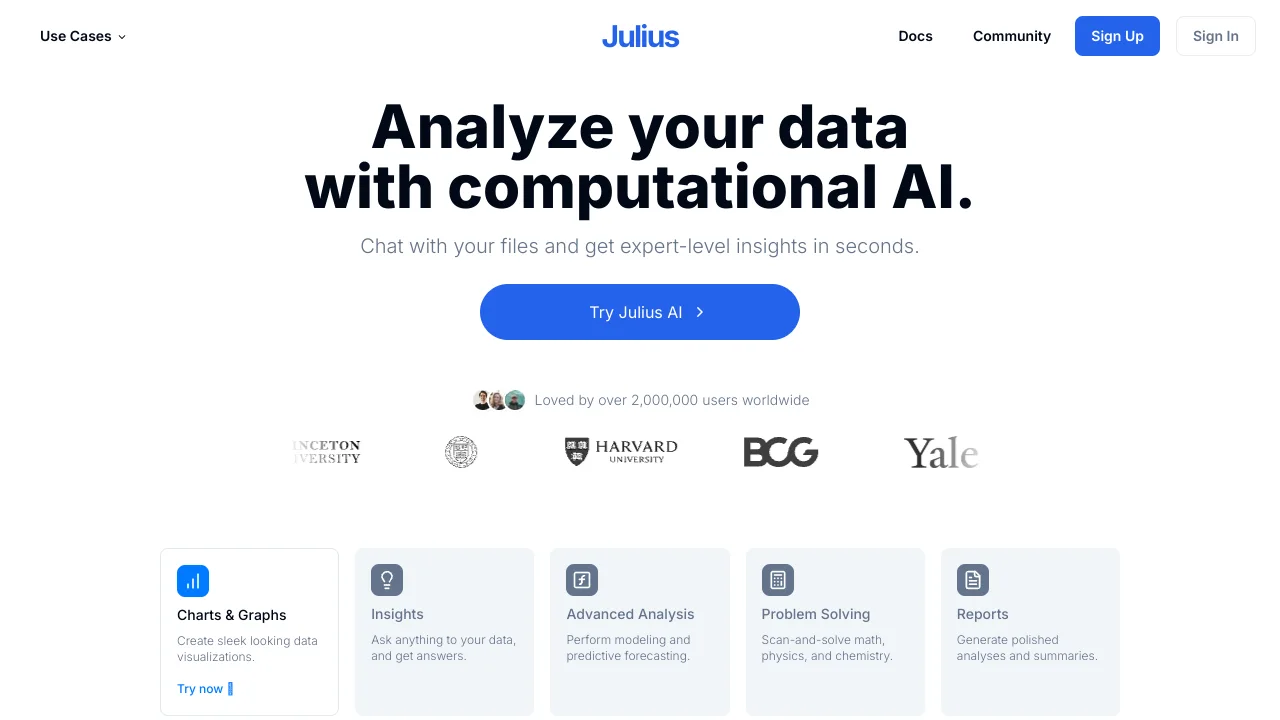
The Core Promise: Conversational data analysis with no coding required
The fundamental principle behind Julius is its conversational interface. Unlike Excel or Python, which require users to know formulas and code, Julius allows you to ask questions about your data in plain English. For example, you can simply ask, “What is the average sales price by product category?” or “Show me a chart of our monthly revenue trends.” The platform’s powerful AI models translate these natural language data queries into a complete analysis, generating charts, summaries, and reports instantly. This eliminates the technical barrier and makes sophisticated data analysis platform functionality accessible to everyone.
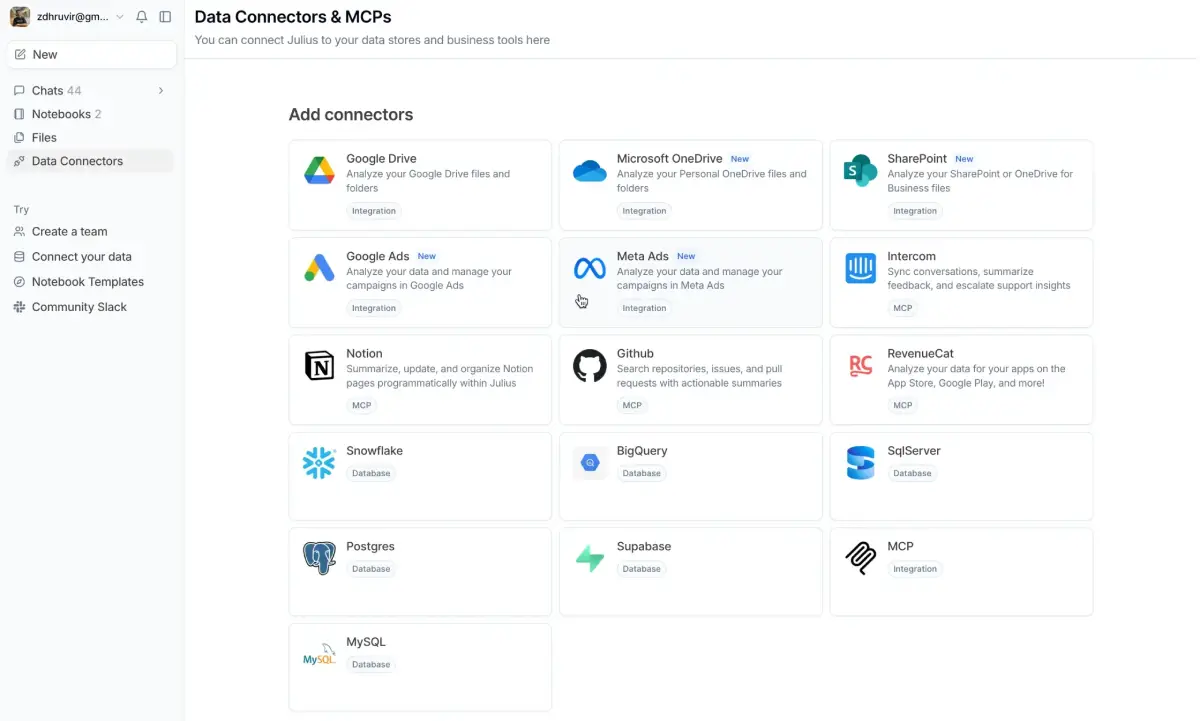
Key Use Cases: Who is this AI data tool for?
Julius is a versatile tool with applications across a wide range of industries and professional roles. Its no coding required approach makes it an ideal solution for anyone who works with data but lacks a technical background.
-
Business reporting and financial analysis: Julius is a powerful asset for business owners and financial analysts. It allows them to quickly upload financial statements, sales reports, and budget data to perform complex tasks like cash flow forecasting, budget-versus-actuals analysis, and profitability reporting. Instead of building a complex model in a spreadsheet, they can simply ask the AI to “analyze which factors influence quarterly revenue” or “find unusual patterns in expense categories.” This significantly speeds up business reporting and empowers more people to get valuable insights.
-
Marketing analytics and sales analysis: In the marketing and sales departments, Julius helps teams move beyond basic dashboards to find deeper insights. Users can upload campaign data from various sources to analyze customer behavior, compare conversion rates across different channels, and perform predictive analytics to forecast future sales trends. The AI can quickly identify key performance indicators (KPI dashboards) and generate visual reports, making marketing analytics and sales analysis more efficient and data-driven.
-
Academic research and data storytelling: Julius is also gaining traction in academic settings. Researchers and students can use the platform to perform statistical analysis, conduct hypothesis testing, and visualize complex datasets without wrestling with statistical software like SPSS or R. Beyond the analysis, Julius assists in data storytelling by generating clear, concise summaries and reports that transform raw data into a compelling and easily understandable narrative. This makes the entire research process more efficient and allows a focus on interpretation rather than on the technicalities of data manipulation.
How Julius.ai Works to Simplify Data
At its heart, Julius.ai is not just a chatbot; it is a sophisticated AI data tool that combines the power of large language models with a specialized data analysis engine. This allows it to perform complex tasks by writing and executing code behind the scenes, all based on your plain-language commands. The key to its success is a seamless, user-friendly workflow that removes technical barriers and puts data insights directly at your fingertips.
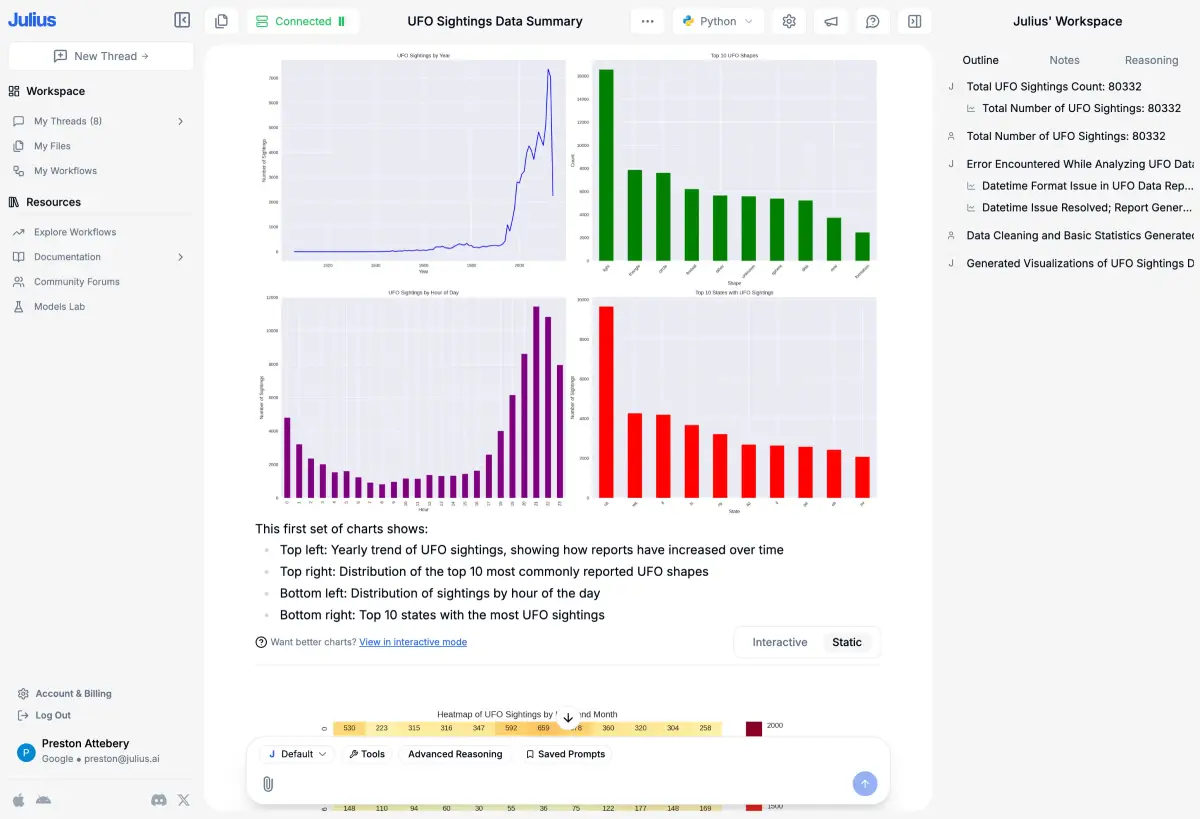
The Conversational Interface
The foundation of Julius’s user-friendly interface is its conversational chat. This allows you to interact with your data in a way that feels natural and intuitive, asking questions as you would to a human data analyst.
-
How to get started with Julius.ai and file upload (CSV, Excel, PDF): Getting started with Julius is designed to be a frictionless experience. You begin by uploading your data, a process that is as simple as dragging and dropping a file directly into the chat window. Julius supports a wide range of common formats, including CSV, Excel, and PDF, as well as other file types. Once your data is uploaded, you can start a conversation, and the platform will retain the context of your dataset for the entire session. For more advanced users, Julius also offers direct data connectors to databases like PostgreSQL, BigQuery, and Snowflake for real-time analysis.
-
The benefits of natural language data queries: The biggest advantage of Julius is its ability to understand and execute natural language data queries. Instead of writing formulas or code, you can simply ask questions like, “Show me the average sales by product category” or “What is the correlation between marketing spend and lead conversion rates?” This dramatically reduces the time to insight, enabling business users, marketers, and students to get answers instantly without waiting for a data analyst. It makes data exploration an accessible, self-service activity for anyone.
Data Visualization & Insights
Raw data can be difficult to interpret, so Julius automatically transforms it into clear, visual representations that make it easy to understand trends and patterns.
-
How to create charts with Julius.ai and customizable dashboards: Creating charts with Julius is as simple as asking. You can request a variety of plot types, including line charts, bar charts, scatter plots, and more. For example, a simple command like, “Create a line graph of sales over the past year,” will generate a professional-looking chart instantly. All visualizations are fully exportable and can be compiled into customizable dashboards that provide a high-level overview of your most important metrics. This feature empowers you to turn raw data into a compelling visual story effortlessly.
-
Generating AI-generated summaries and shareable reports: Beyond just charts, Julius provides AI-generated summaries that explain the key findings and trends within your data in clear, concise language. This capability is invaluable for creating shareable reports for stakeholders who may not be data-savvy. You can export these full reports with charts and summaries, making it easy to communicate your analysis and findings across your organization.
Advanced Analytical Capabilities
For users who need to go beyond basic visualization, Julius offers a suite of advanced features that can perform complex statistical tasks with no coding required.
-
AI for data cleaning and visualization: Before any analysis can be done, data must be clean and organized. Julius provides powerful AI for data cleaning and manipulation. You can ask the AI to identify and remove missing values, correct inconsistencies, or transform data columns into a more usable format. The AI can even identify potential outliers or anomalies, helping you to ensure the accuracy and reliability of your analysis.
-
How to build a forecasting model with AI and perform statistical analysis: Julius’s analytical power extends to statistical analysis and predictive modeling. With a simple prompt, you can perform sophisticated tasks that would normally require a data scientist. For example, you can ask the AI to “build a forecasting model for my sales data” or “perform a regression analysis to determine the relationship between X and Y.” The AI will run the underlying code and provide a clear explanation of the results, making advanced analysis accessible to everyone.
Julius.ai vs. Competitors: A Head-to-Head Comparison
Choosing the right AI data tool is a critical decision, as the market is filled with both generalist and specialist solutions. To help you make an informed choice, this section provides a head-to-head comparison of Julius.ai with its most prominent rivals, revealing its key strengths and where other platforms might have an edge.
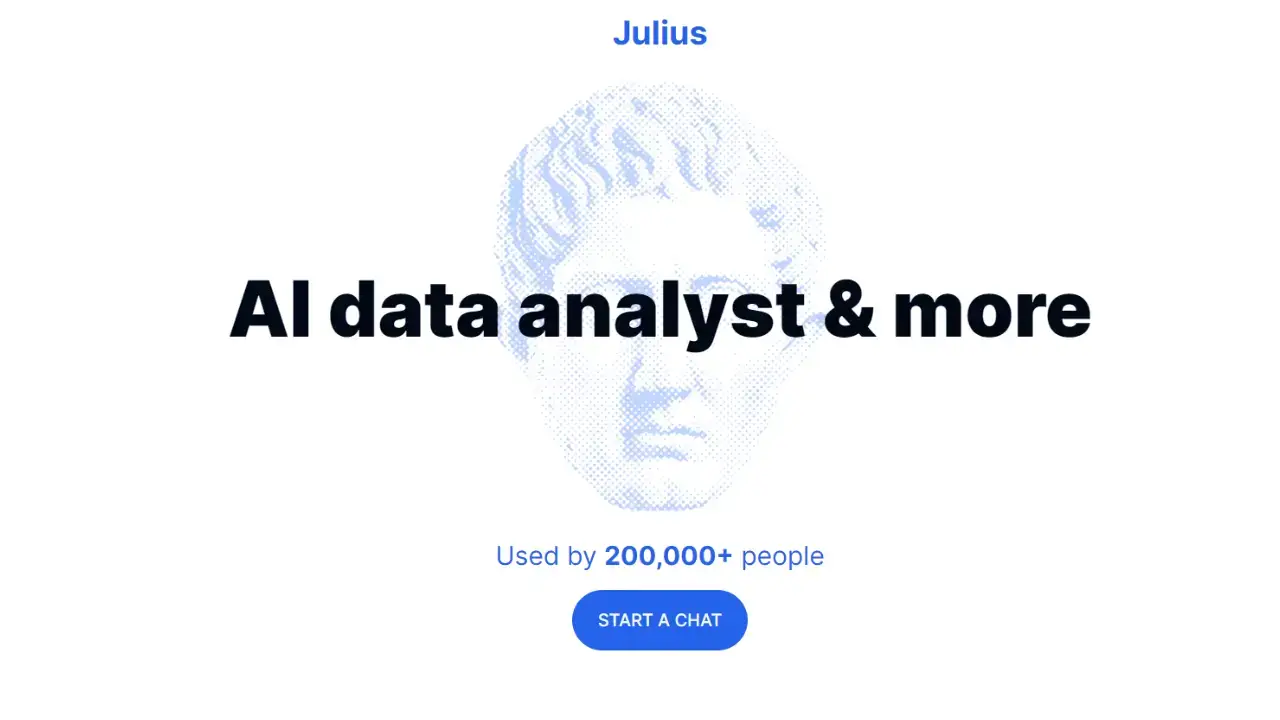
Julius.ai vs. ChatGPT for data analysis
This is the most common and crucial comparison, as many users turn to ChatGPT for data tasks. While both tools use natural language data queries, they are built for fundamentally different purposes. ChatGPT is a highly versatile AI answer engine designed for a wide range of tasks, from writing code to generating creative text. It can perform basic data analysis, but its generalist nature means it often requires more specific prompting to get the desired output.
In contrast, Julius.ai is purpose-built for data. Its architecture is optimized for analytical tasks, allowing it to handle much larger datasets (up to 32GB vs. ChatGPT’s 50MB limit). It also supports more programming languages for analysis, including Python and R, and can seamlessly generate charts and visualizations with minimal effort. While ChatGPT is great for quick, ad-hoc questions, Julius provides a more robust, streamlined, and accurate experience for a deep dive into data.
Why choose Julius.ai over Excel for data work?
While Excel has been the industry standard for decades, it is a manual, formula-based tool. Julius.ai represents a fundamental shift in how data is handled. It automates the most time-consuming parts of data work and provides powerful insights that would be difficult or impossible for a non-expert to find in a spreadsheet.
The primary reason to choose Julius.ai is its ability to analyze spreadsheets without code. Instead of spending hours writing complex formulas or creating pivot tables, you can simply ask Julius a question in plain English. The platform handles the underlying calculations, data cleaning and manipulation, and even identifies hidden trends for you. This makes it an ideal replacement for Excel for anyone who wants to perform statistical analysis, build a forecasting model with AI, or simply get answers from their data faster.
The best Julius.ai alternatives
While Julius.ai is a top-tier AI data analyst, several alternatives offer different features and cater to specific needs.
-
Deepnote and Hex are excellent for data scientists and teams who want a collaborative notebook environment with built-in AI assistance. They offer a powerful, hybrid approach that combines code with natural language for more advanced users.
-
Tableau Pulse is an AI feature within the popular business intelligence platform, ideal for businesses that are already invested in the Tableau ecosystem and want to add generative explanations and insights to their existing dashboards.
-
Powerdrill AI is a newer contender that claims to be more accurate and cost-effective than Julius.ai, with additional features like one-click presentation and report makers.
Ultimately, the best alternative depends on your expertise and what you need to achieve. For non-technical users and teams who just want fast, clear answers from their data, Julius.ai is a very strong choice.
Julius.ai Pricing, Pros, and Cons: Is it Worth the Cost?
When considering a specialized AI data tool, the investment is a crucial factor. Julius.ai positions itself as a premium service, and its pricing reflects the value it provides in automating complex analytical tasks. To determine if Julius is worth it, it’s essential to weigh its costs against its tangible benefits and known limitations.
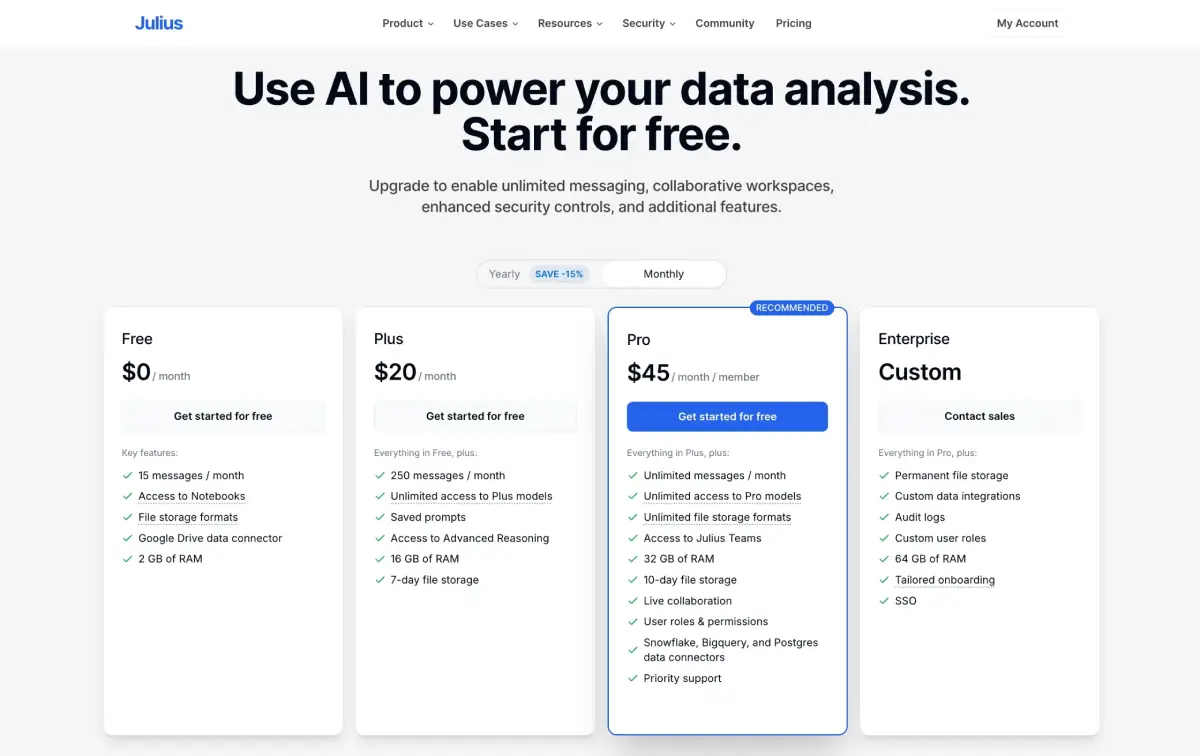
Julius.ai pricing and plans Explained
Julius offers a tiered pricing model designed to cater to a range of users, from individuals to large enterprises. The plans are based primarily on usage, which can be an attractive feature for teams with fluctuating needs.
-
Is Julius.ai free to use? (The free plan for individuals): Yes, Julius.ai offers a robust free plan that is ideal for individuals looking to test the platform or complete small, one-off projects. The free tier includes a limited number of conversational queries per month, which is sufficient for exploring its core functionalities, such as data visualization and basic analysis. This allows new users to experience the power of a conversational data analyst without any financial commitment.
-
Julius.ai team pricing and enterprise solutions: For professionals and businesses with more demanding data needs, Julius offers a paid “Plus” plan, which provides a significant increase in message limits, and a “Pro” plan for unlimited messaging and access to a wider range of AI models. For larger organizations, the “Enterprise” plan offers custom pricing and advanced features like permanent file storage, tailored onboarding, and robust security controls, including SSO and audit logs, making it a scalable solution for high-stakes business reporting and analysis.
The Pros: What Users Love in Julius.ai user reviews and ratings
Based on Julius.ai user reviews and ratings, the platform consistently receives high marks for its core value proposition.
-
High accuracy from specific AI models and robust customer support: Unlike a generalist AI, Julius is architected specifically for data work, leading to a much higher degree of accuracy in its analyses. The platform provides access to a variety of cutting-edge AI models, including GPT-5 and the latest Claude versions, ensuring that it is running on the most powerful technology available. Furthermore, users often praise its customer support, highlighting the reliability of its help center and priority support for paid plans.
-
The ability to chat with your data and get instant insights: The biggest selling point of Julius is its conversational interface. The ability to simply “chat with your data” and receive instant, insightful answers transforms the data analysis process. Users can quickly identify trends, generate summaries, and perform complex queries without a single formula or line of code. This dramatically reduces the time to insight, enabling even non-technical users to make data-driven decisions.
The Cons: Key Limitations and the Learning Curve
Despite its many strengths, Julius also has a few limitations that are important to consider before making a commitment.
-
Occasional AI “hallucinations” and a steeper learning curve for advanced users: While highly accurate, all generative AI tools carry a risk of “hallucination” or occasional misinterpretation of user prompts, particularly with ambiguous data. While the basic interface is simple, users looking to perform more complex tasks like building forecasting models with AI or using specific code within a Notebook may encounter a learning curve to master the platform’s advanced functionalities.
-
User concerns about live dashboards and the pricing model: Some users have expressed concerns about the lack of permanent file storage and a live dashboarding feature on lower-tier plans, which means that for continuous, real-time reporting, they may need a separate business intelligence tool. Additionally, the pricing model’s jump from individual to team and enterprise plans can feel steep, leading some users to question the value for a larger-scale deployment.
Final Verdict: Is Julius.ai the Right AI Data Tool for You?
When deciding on an AI data tool, the ultimate question is whether its value proposition justifies the cost and effort. Julius.ai has proven itself to be a powerful and specialized solution, but its ideal user is not everyone. The final verdict comes down to your specific needs, your current workflow, and your professional goals.
Answering the ultimate question: “Is Julius.ai worth it?”
Yes, Julius.ai is absolutely worth it for individuals and teams who regularly work with data and want to eliminate manual, time-consuming tasks. The value lies in its ability to democratize data analysis by making complex tasks like statistical analysis and forecasting models accessible to anyone.
Julius.ai is most valuable for users who:
-
Need to save time: If you spend more than a few hours a week in Excel or similar spreadsheets, Julius will pay for itself by automating data cleaning, manipulation, and reporting.
-
Lack technical skills: It’s a perfect tool for business professionals, marketers, and researchers who need to get actionable insights from their data without writing any code. The ability to simply chat with your data is a game-changer for non-technical users.
-
Need a purpose-built tool: Unlike generalist AI chatbots, Julius is built specifically for data, leading to higher accuracy and better results for analytical tasks. Its ability to handle massive files (up to 32GB) is a key advantage for teams working with large datasets.
While the pricing model and learning curve for advanced features may be a concern, the efficiency gains and the sheer power of its AI-powered data analyst engine make it a strong investment. The free plan allows for a risk-free trial, providing an easy way to see if it can become your next essential AI data tool.
Frequently Asked Questions (FAQs)
This section provides quick, easy-to-digest answers to the most common questions about Julius.ai, helping you get the information you need to make a fast and informed decision.
- How to use Julius.ai for data analysis?
Using Julius.ai is a conversational process that requires no coding. You start by uploading your data file (e.g., a spreadsheet) or connecting to a live database. Then, you simply type a question or command in plain English, such as “Show me the top 5 products by sales” or “Create a bar chart of monthly revenue.” The AI will then write and execute the underlying code to provide the answer, complete with charts, tables, and summaries.
- What is Julius.ai’s conversion funnel?
The search results do not indicate that “conversion funnel” is a specific, built-in feature of Julius.ai. The platform is an AI data analyst designed to help users analyze data, not to build marketing funnels. However, you could use Julius.ai to analyze a conversion funnel by uploading data from your marketing tools and asking the AI to find key drop-off points or track the performance of different stages.
- Can Julius.ai connect to a live database?
Yes, Julius.ai offers “Data Connectors” that allow it to connect directly to live databases and data warehouses. The platform supports out-of-the-box connections to popular sources like PostgreSQL, BigQuery, Snowflake, and Google Sheets. This feature eliminates the need for manual file uploads and allows you to work with real-time, up-to-date data.
- What data file types does Julius.ai support?
Julius.ai supports a wide range of data file types, including the most common formats like CSV, Excel (.xls, .xlsx, .xlsm), and PDF. It also supports other formats such as JSON, Parquet, and text files. This versatility ensures you can use the platform with almost any data source you have, making it a highly flexible AI data tool.
- Why choose Julius.ai over Excel?
You would choose Julius.ai over Excel for speed, simplicity, and the power of its automation. While Excel is a powerful manual tool, Julius.ai allows you to analyze spreadsheets without code. It automates time-consuming tasks like data cleaning and manipulation, formula writing, and visualization, which can save you hours of work. For users who need quick insights, the ability to simply ask a question in natural language and receive an immediate chart or analysis is a significant advantage over Excel’s manual workflow.
Featured AI Tools
Submagic makes your short-form videos captivating with AI captions, b-rolls, and smart edits. Save time and grow your social media reach effortlessly.
Create AI videos from text, photos, audio, slides, and more using KreadoAI’s media assets, effects, and stickers. Instantly turn your ideas into stunning
Transform your ideas into stunning videos with our AI video generator. Easy to use Text to Video editor featuring lifelike voiceovers, dynamic AI video clips.
Elevate your content with Boolvideo: Turn your resources into engaging videos easily! Drive leads, boost sales, amplify reach with the AI Video Generator.




